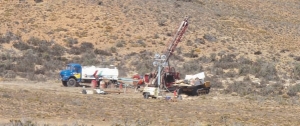VANCOUVER — For years the Cerro Moro gold-silver project in Argentina’s Santa Cruz province played second-fiddle to Exeter Resource’s (XRC-T, XRA-X) sizable Caspiche gold project in Chile, but the project is now advancing quickly as the prime focus of spin-out company Extorre Gold Mines (XG-V).
The new company was created in March to allow both Exeter and Extorre to focus on their main assets. Eric Roth, who came aboard Exeter 18 months ago as a consultant and then became its Argentine mine development manager, has since become president and CEO of Extorre.
“It was getting very difficult to get the funds to focus on taking something like Cerro Moro forward,” says Roth of the spin-off during a phone interview, “because it’s a relatively small orebody but very high grade, whereas Caspiche is at the other end of the grade-tonnage curve. . . so there was a lot of internal competition.
“The split made sense, too, in terms of the development going forward because obviously we recognize that Cerro Moro, being a relatively small but very high-grade system, was something we could put into production ourselves,” adds Roth.
The company’s split went smoothly, according to Roth, with no changes to the development teams on the ground. On a corporate level, Exeter shareholders received one share of Extorre for each Exeter share, while the new company also received $25 million in working capital and Exeter’s other Argentine exploration properties.
“It has worked really well,” says Roth of the split. “We’ve been able to dedicate the time and really take things forward.”
Extorre recently released a preliminary economic assessment (PEA) on the project that outlined a 750-tonne-per-day open-pit and underground operation.
The PEA outlines an 8-year mine life producing a total of 436,000 oz. gold and 21.4 million oz. silver. For the first five years, production averages 133,500 oz. gold equivalent per year at an average cash cost of US$201 per oz. gold.
The study pegged capital costs at US$130 million including a US$21-million refundable value added tax, with payback in 1.8 years on a 0% discount basis. The after-tax internal rate of return was set at 43.4% and the undiscounted after-tax cash flow at US$186 million. Recoveries are estimated at 95% for gold and 90% for silver.
“One of the nice things about the project is that even on a small scale in terms of throughput, the very high grades translate to a nice quantity of ounces and a very low cash cost,” says Roth.
The mine plan was based on a resource estimate released in April that outlined 590,000 indicated tonnes grading 18.9 grams gold per tonne and 805 grams silver per tonne and a further 1.97 million inferred tonnes grading 3 grams gold and 190 grams silver.
Along with development work, Roth says that the company is focusing on exploration. Extorre has four rigs on site, drilling about 6,500 metres a month, with a burn rate of under US$2 million a month.
“We’re very conscious of the fact that it’s a relatively modest resource at the moment,” says Roth, “but we’ve stated as a goal that we’d like to get the project up past 2 million oz. gold equivalent, so basically we’re working towards that.”
The company has already found more than 30 veins in the area and followed up on only a few, while its property spans 175 sq. km of mining concessions for future exploration.
Cerro Moro is a low-sulphidation epithermal gold-silver district, with veins at the project typically narrow, sub-vertical and characterized by multiple phases of quartz-adularia plus or minus gold-silver deposition. The Escondida deposit, where the entire indicated resource sits, has been tested along a 2-km strike and to 200 metres depth.
The company submitted its environmental impact assessment in September and expects approval late in the first quarter of 2011. Extorre plans to have an updated resource and a prefeasibility study finished by the second quarter of next year.
As to hurdles in developing the mine, Roth says that finding skilled underground labour will be difficult. Despite the prevalence of mining in Santa Cruz, the mines are primarily open-pit operations.
“You basically just don’t have those (underground skilled) people available at the moment, you need to bring people in from the outside,” says Roth. “It’s not to say the locals couldn’t do it, it’s just they’ve never had the opportunity to be trained.”
Since Extorre listed in March, its stock price has climbed from $1.30 to a high of $5.50 in early September and recently closed at $5.09. In mid-September, the company raised $40.5 million in a bought-deal financing and now has 87 million shares outstanding.


Be the first to comment on "Extorre Gold advances Cerro Moro"